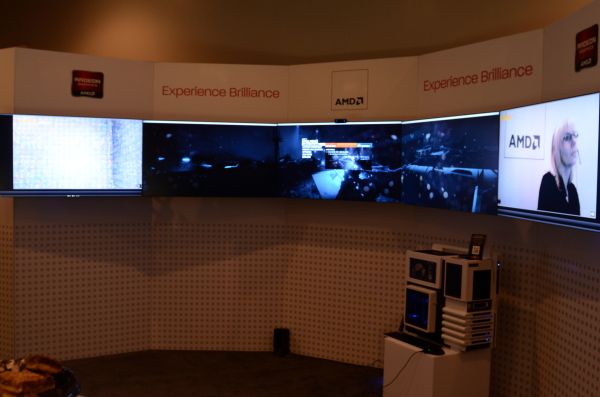AMD's 4K and BF3/Video Conferencing Eyefinity Demos at CES
by Anand Lal Shimpi on January 13, 2012 10:47 AM EST- Posted in
- Trade Shows
- AMD
- CES
- GPUs
- CES 2012
One of the underlying themes of CES this year was the transition to 4K displays. AMD had a 4K (4096 x 2160) demo at its booth driven by a Radeon HD 7970. Most 4K displays require multiple inputs, which was the case in AMD's demo. Two DisplayPort outputs from the 7970 drive the panel in the shot above. AMD ran both video playback and a 3D rendered test as a proof of functionality. If the high-end of the PC space moves to 4K eventually that will continue to drive high-end GPU demand thanks to the 2.1x increase in pixel count over a standard 30-inch display.
AMD also had a 5x1 Eyefinity setup (not using 4K displays) running off of two 7970s showing a video conferencing app (ooVoo) running alongside Battlefield 3. This was of course one of the original intents of Eyefinity: to deliver a more immersive experience. The addition of video conferencing is a nod to a usage model where you are not only playing a game that makes you feel immersed but you're also able to look to your left and right and see your teammates.











29 Comments
View All Comments
Kristian Vättö - Friday, January 13, 2012 - link
AMD 7970 supports DisplayPort 1.2 which is capable of 4K, so why were two DPs needed? Firmware limitation? I know AMD states 2560x1600 as the max resolution, but DP 1.2 spec is capable of more.yankeeDDL - Friday, January 13, 2012 - link
From the article: "Most 4K displays require multiple inputs, which was the case in AMD's demo"Translate: a single TV input does not support 4K (which means it is not a displayport 1.2), regardless whether the 7970 can, or cannot support 4K on one output.
Kristian Vättö - Friday, January 13, 2012 - link
Yeah, but why make a new display that doesn't support the newest DisplayPort standard? I would understand if DVI was used. I just find this to be a bit weird because the technology for 4K over one cable exists.JarredWalton - Friday, January 13, 2012 - link
I think it might have simply been an early prototype display and that when they're ready to start shipping it will only need a single connector.euler007 - Friday, January 13, 2012 - link
I'm pretty sure AMD was promoting their graphic cards as a source for these display.As far as I know they're not selling or making any displays.
bunnyfubbles - Friday, January 13, 2012 - link
Only improved ROP efficiency, granted, by the time 4K and higher displays become common place the 7970 will be ancient history, but still, can't help but be disappointed by the 7970's conservative design, although I'm sure that helped it in actually making it out to market while we're still such a long ways off before we get Kepler.Can't have our cake and eat it too I guess, GLaDOS was on to something.
tipoo - Saturday, January 14, 2012 - link
What workload do you find bottlenecked by ROPs? AMD said improved efficiency was enough as current applications don't max out ROPs. And yes, of course by the time 4k becomes common this will be history, as that's still years down the line. Graphics cards have a pretty high performance turnover rate, that's nothing new.Assimilator87 - Friday, January 13, 2012 - link
Wow, those are some of the thinnest bezels I've seen yet. What's the make and model?JarredWalton - Friday, January 13, 2012 - link
Digital Signage displays that are really thick (about four inches) and cost a truckload of money. I think AMD may have said something about them running in the neighborhood of $10K or more each. Also note that because they're digital signage, they have to put out a lot more light than normal displays, so they can probably output 1000 nits or something -- which would also explain the extra thickness on the back, as it looked like the power delivery and backlighting was about 3x as large as, e.g. a 30" 2560x1600 display.HammerStrike - Tuesday, January 17, 2012 - link
Assuming we are talking about the 5x1 configuration, those displays are not $10K each. I can't say definitively what the make or model is, but my guess would be a Samsung UX or UB series display - they are commercial screens designed for video walls, hence the super slim bezels. Those look like 46" displays - the 46" 460UX-3 can be easily had for $1800 or less. Also, unless you want to shine a spot light on the screen, 1000nits is way overkill for an indoor screen. The extra thickness on the back is part the result of these being back light (CCFL lighting, combined with the fact that even if it were LED there is no room in the bezel) and other part increased air flow design for 24x7/close quarter operation. There are outdoor displays that offer 1500+ nits, such as Sunbrite TV's or the DR series from Samsung), but their bezels are much thicker and are definitely not those models.